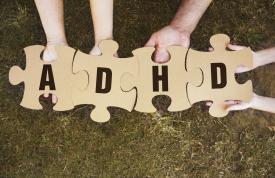Key Points:
- Fidgeting may help students with ADHD concentrate on complex learning tasks.
- Allowing students to fidget and move during class can help improve academic performance.
- Try creating a "Jumping Corner" in the back of the classroom for students who need to move while learning.
ADHD: The Most Common Behavioral Disorder
Attention Deficit Hyperactivity Disorder (ADHD) is the most common behavioral disorder diagnosed in children. Common signs include restlessness, continual talking and inability to concentrate and pay attention. About 11 percent of school-aged children have been diagnosed with ADHD, with 1 in 3 having received treatment with medication and behavioral therapy. Some of these students end up falling behind their peers academically.
New Insight Into Hyperactivity
 A new study published in The Journal of Abnormal Child Psychology suggests that hyperactivity may actually help students overcome their attention problems. Common hyperactive behaviors like running, jumping, rolling on the floor and continual talking are typically viewed as a disruptive problem that should be treated in addition to the attention problems. New research shows these behaviors aren't always present; instead, they are displayed when students are asked to complete tasks involving the executive functioning centers of the brain.
A new study published in The Journal of Abnormal Child Psychology suggests that hyperactivity may actually help students overcome their attention problems. Common hyperactive behaviors like running, jumping, rolling on the floor and continual talking are typically viewed as a disruptive problem that should be treated in addition to the attention problems. New research shows these behaviors aren't always present; instead, they are displayed when students are asked to complete tasks involving the executive functioning centers of the brain.
Researchers found that when students with ADHD were asked to perform a task that involved working memory and organization, those who were allowed to move or fidget did significantly better than those who were asked to keep still. Conversely, children without ADHD did better when sitting still, but worse when moving around.
These findings suggest that students with ADHD actually need their gross motor movements to help them complete challenging intellectual tasks. Rather than being part of the problem, it's likely that hyperactive behaviors help these students stay focused and attend to the task at hand. Researchers describe "excess motor activity as a compensatory mechanism that facilitates neurocognitive functioning in children with ADHD." This means that hyperactivity may be a feature to encourage rather than a bug to fix.
Translating Research Into Effective Teaching
Because traditional classroom management programs seek to reduce or eliminate disruptive behavior, these findings require some new thinking about how to effectively teach students with ADHD. It's a major challenge to maintain a learning environment that respects the needs of traditional learners who thrive in quiet, orderly spaces while allowing students with ADHD the freedom to move. Student safety is also important, so it's crucial for teachers to create a classroom with designated times and spaces for movement. Some strategies for teachers to employ in the classroom include:
- Allowing students to keep a fidget toy in their desks is a small start. Students can take the toy out when they feel like interrupting or jumping up. This can be a ball to squeeze or another toy with interesting tactile properties to keep them physically engaged so they can pay attention.
- Designating a corner of the classroom as an "Activity Zone" or a "Jumping Corner" creates a place where students can retreat when they feel the need to move around. This area is ideally placed in the back of the room where other students will not be distracted, but will allow clear sight lines to the teacher so the student can continue to follow the lesson.
- A yoga ball chair or therapy bands tied to chair legs can help students with ADHD bounce and move without leaving their seats. This is especially effective during tests or writing sessions that require quiet thinking and movement at the same time.
As more research indicates that hyperactive behavior helps students with ADHD overcome concentration struggles to master complex material, it's more important than ever for teachers to find creative ways that support these students within their comfort zones. Allowing students to fidget in a controlled, respectful way can improve academic performance and create a classroom environment that is more comfortable for all learners.


Comments
It makes perfect sense to me
Hi Opal, thank you for
Our schools utilize GoNoodle
Thanks for sharing the
Could improved learning and
Absolutely! Any type of